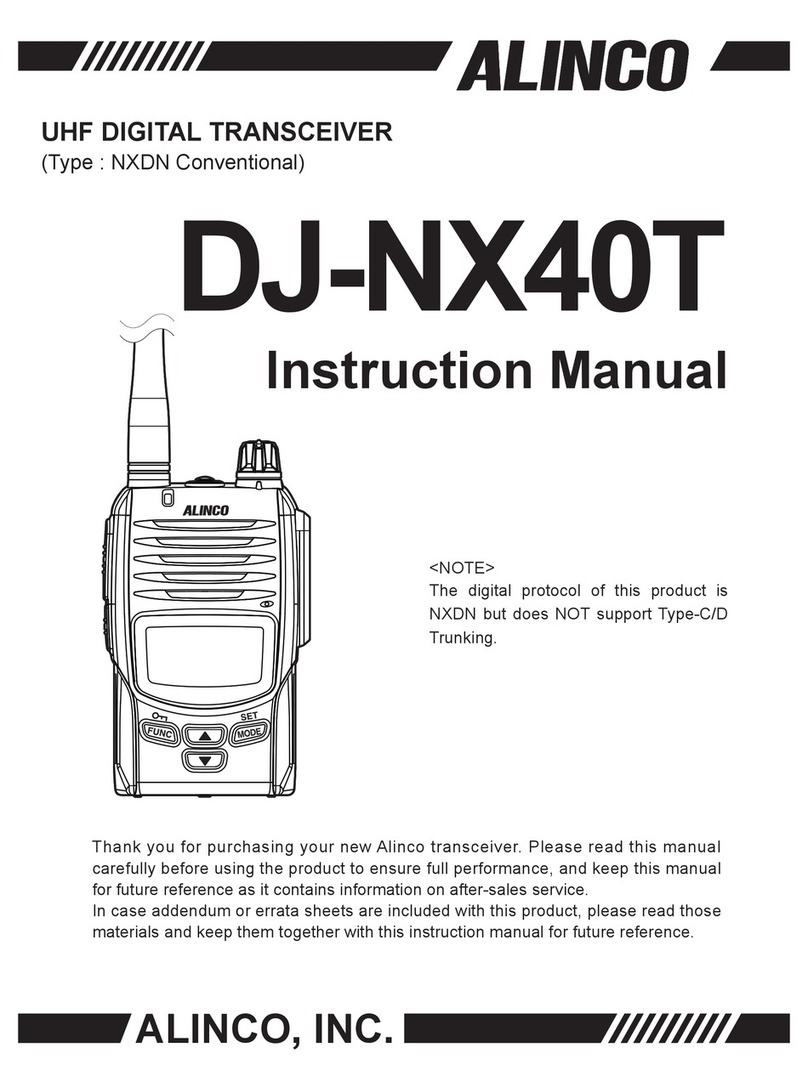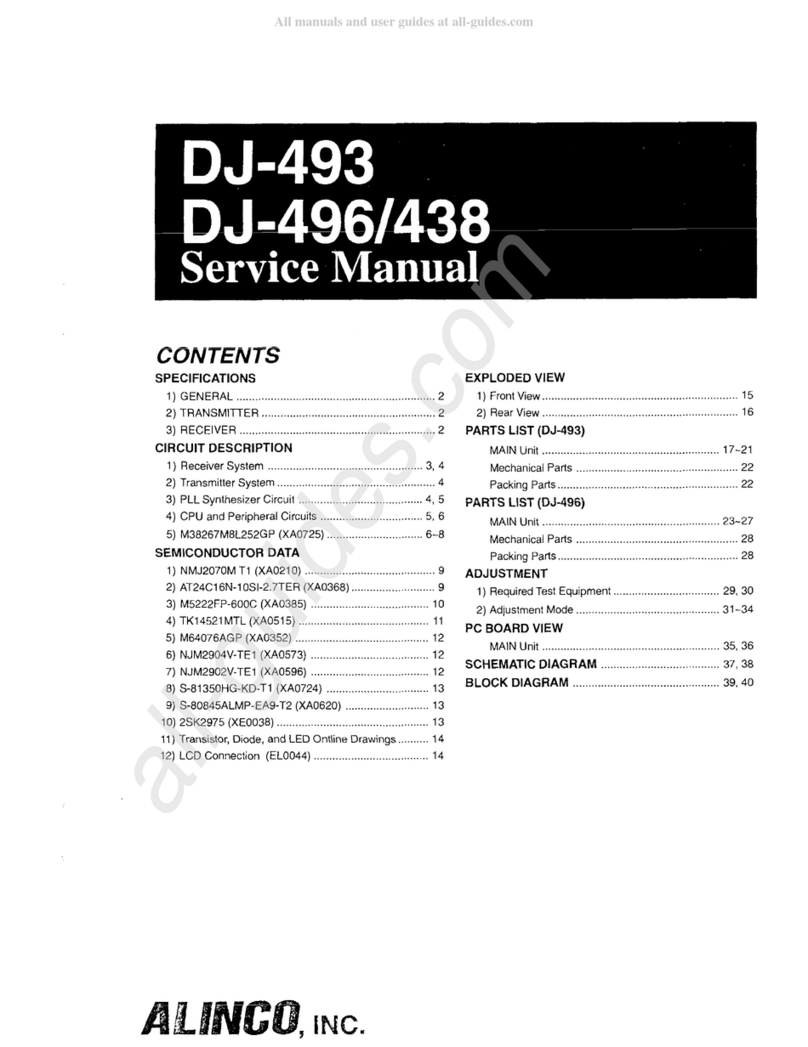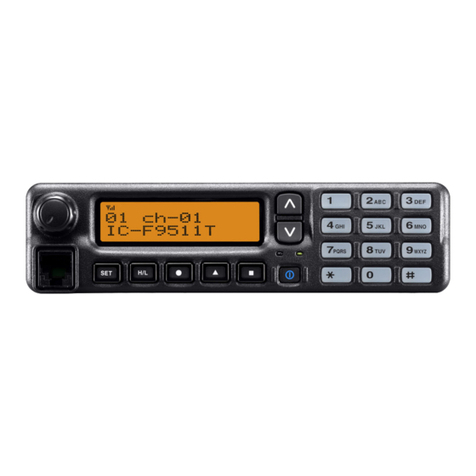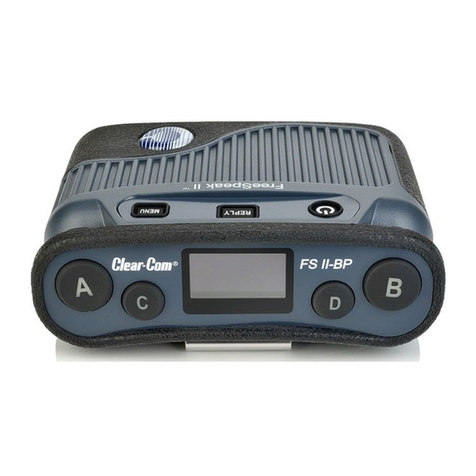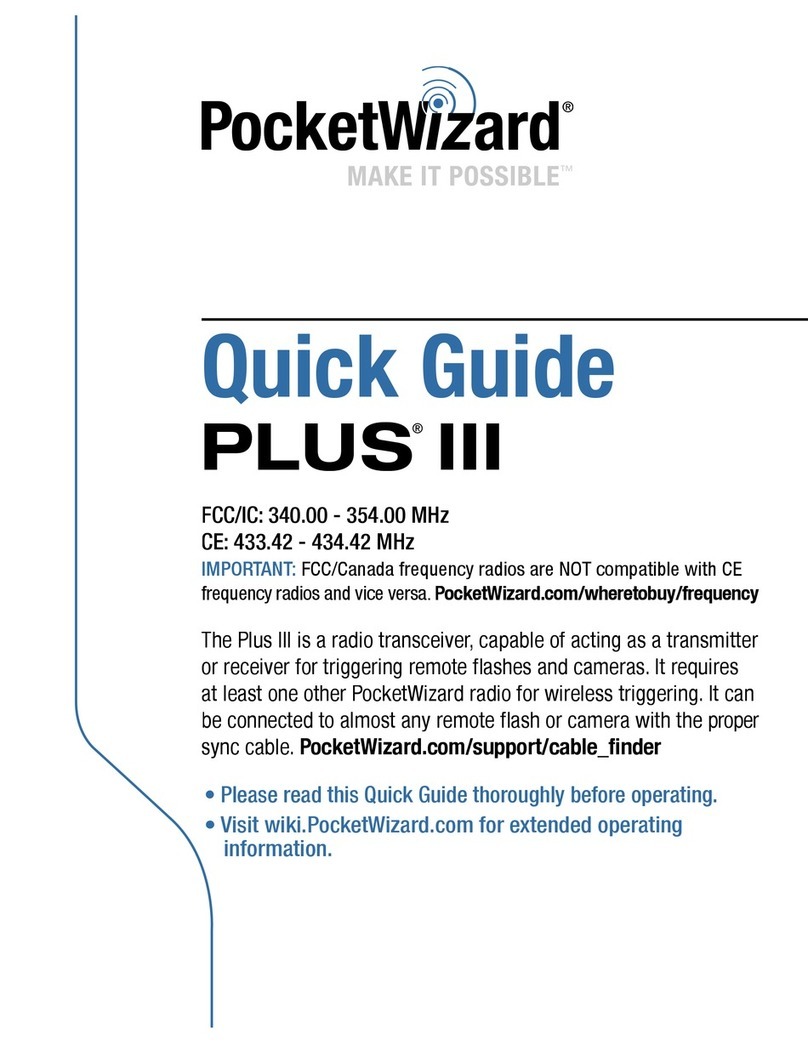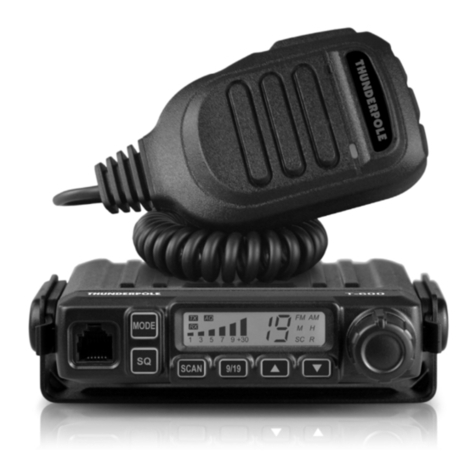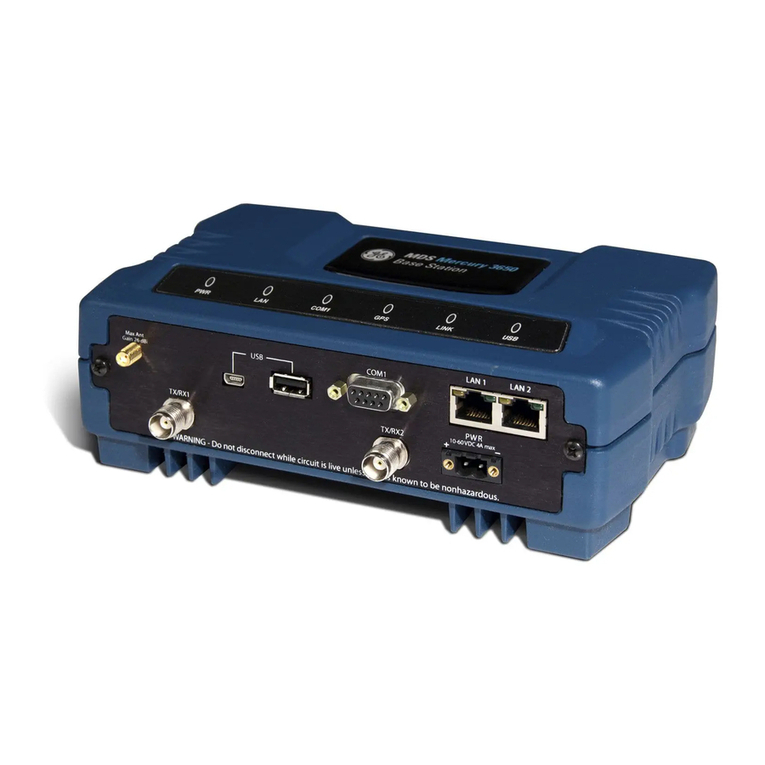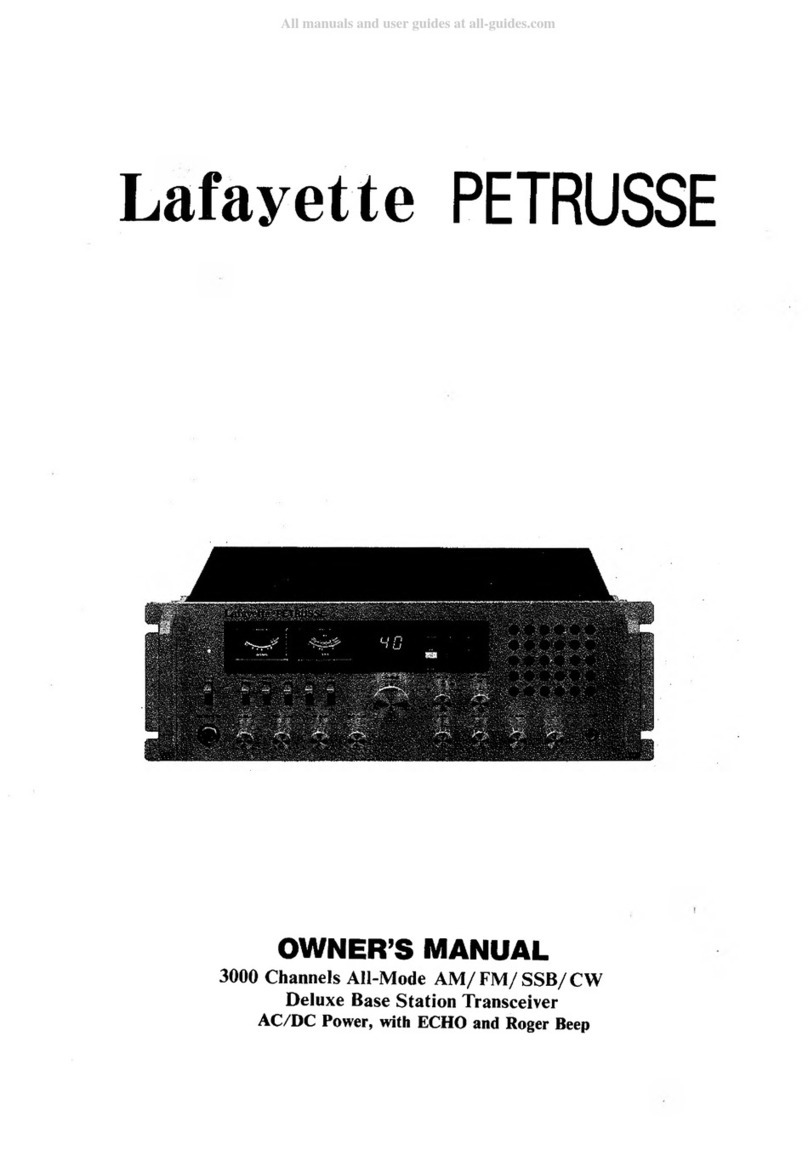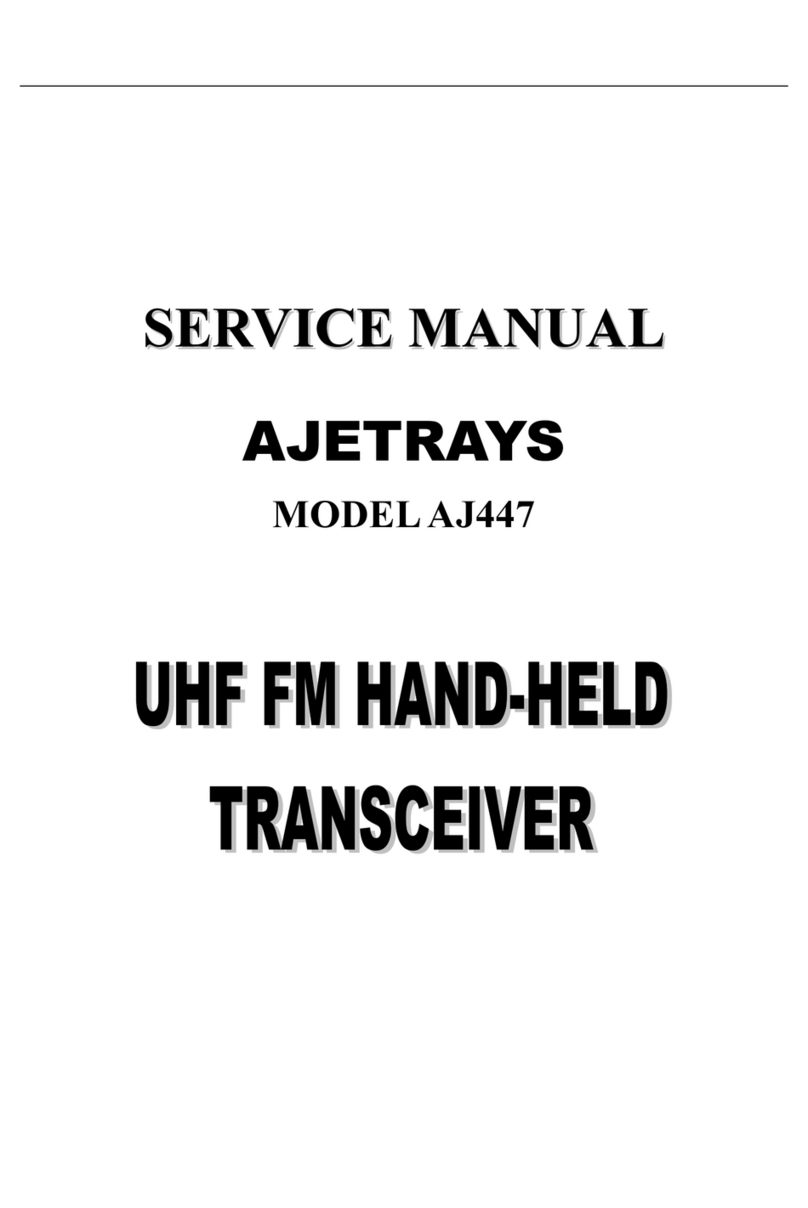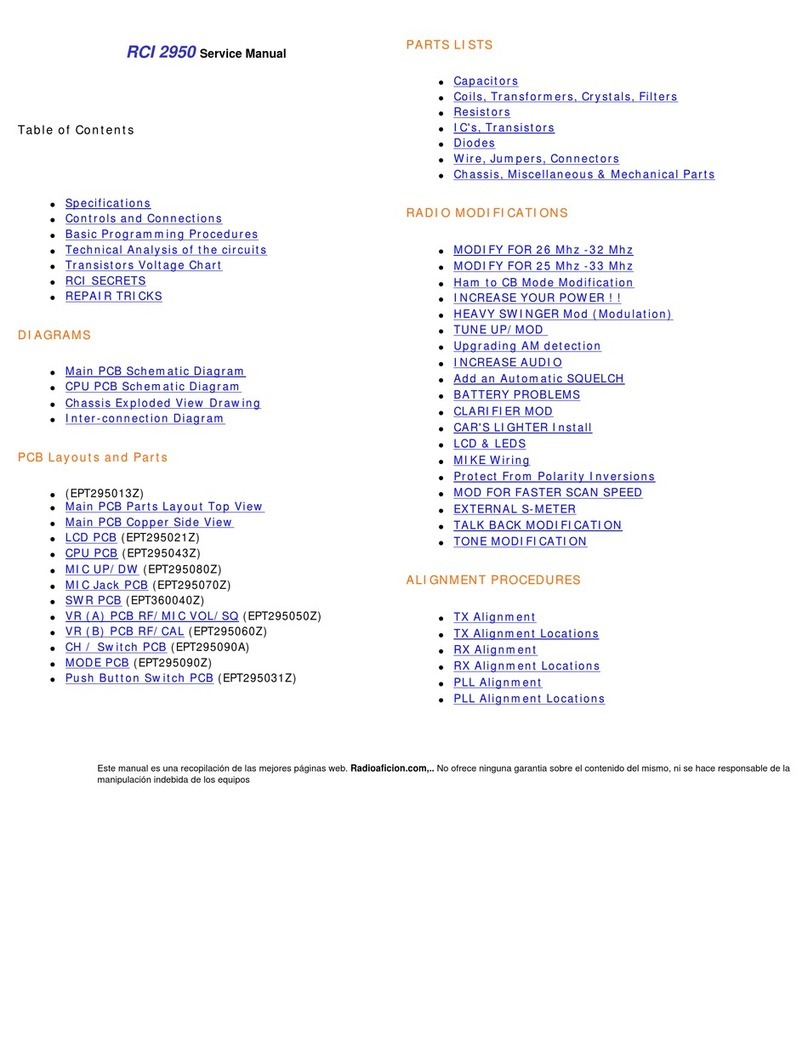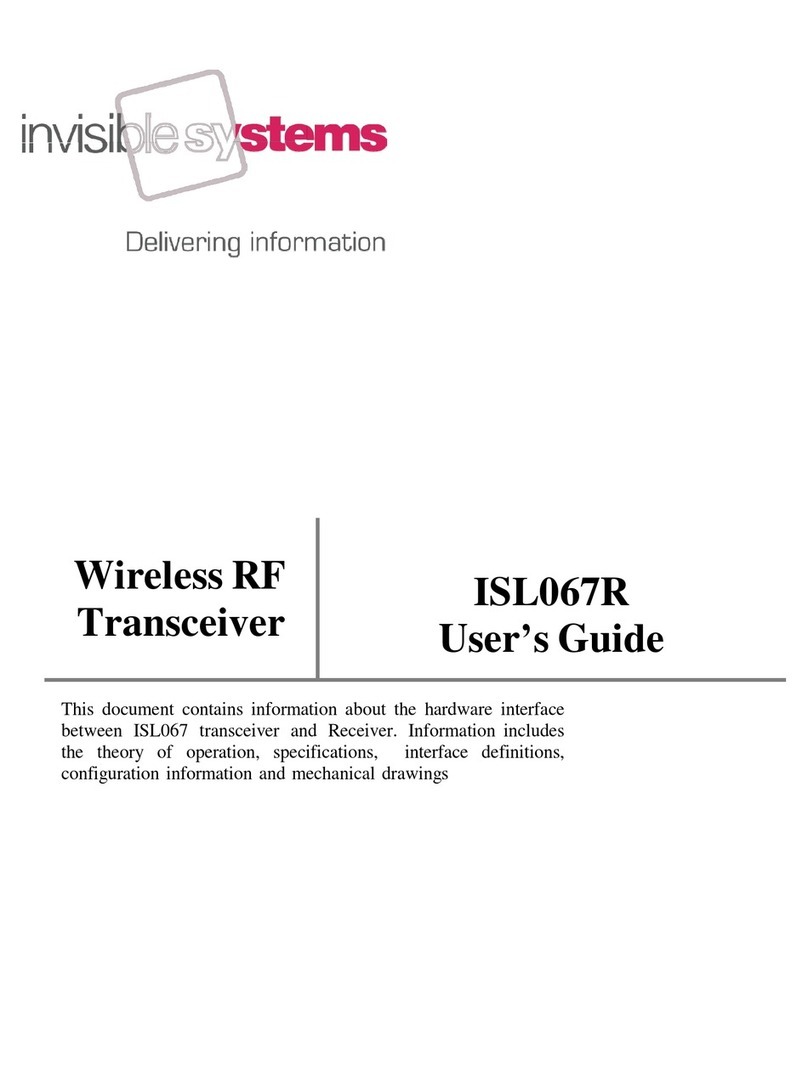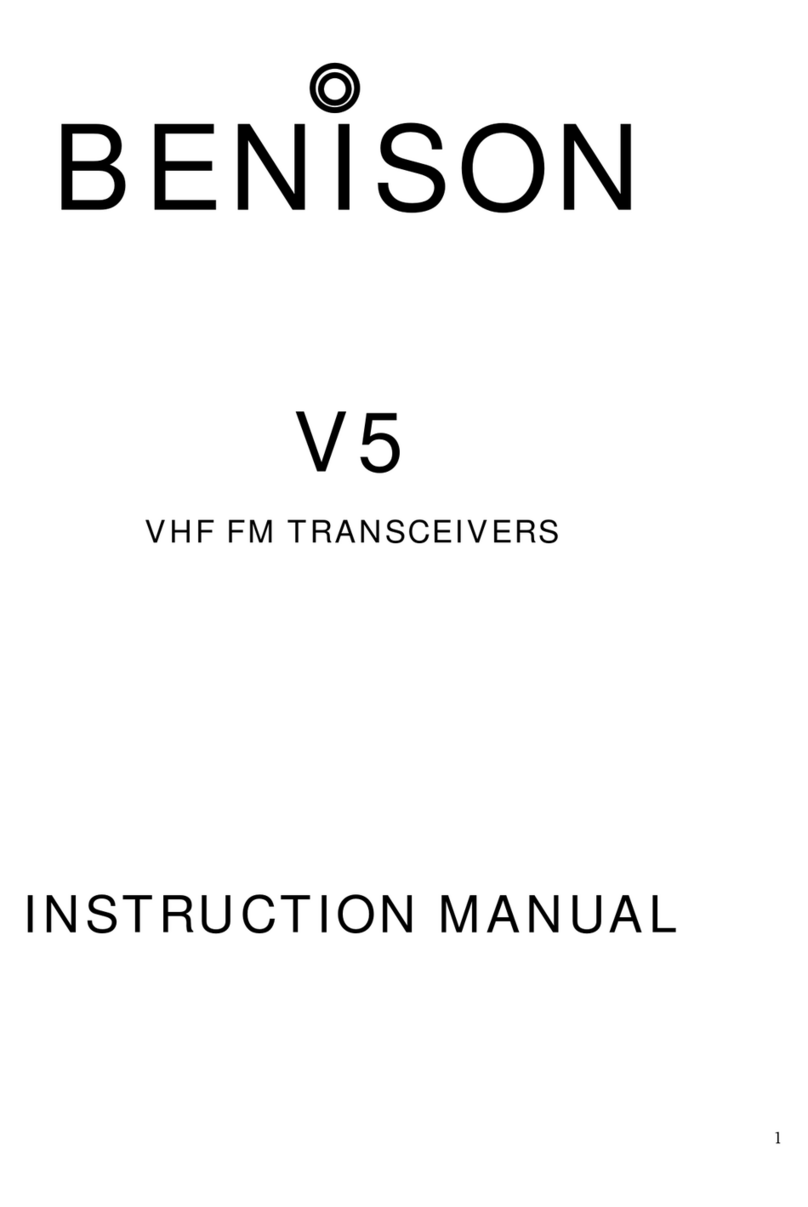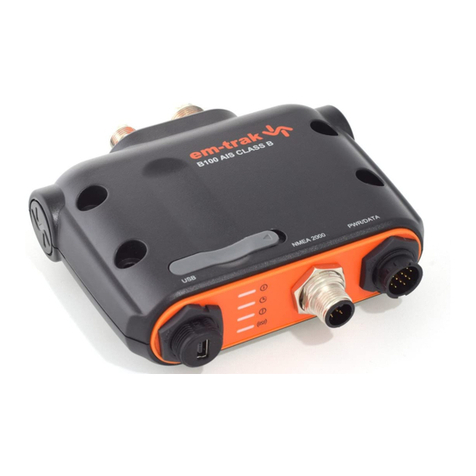Alinco DR-138 User manual

A1.0-12/12
Alinco Incorporated, Electronics Division
Yodoyabashi Dai-bldg 13F
4-4-9 Koraibashi, Chuo-ku, Osaka 541-0043 Japan
Phone: +81-6-7636-2362 Fax: +81-6-6208-3802
http://www.alinco.com
E-mail:[email protected]
Copyright Alinco, lnc. PS0662/FNEF-NJ
Printed in China
VHF FM Transceiver / 136.000-173.9975MHz
All EU and EFTA member states. Operator
license is required.

DR-138
Instruction Manual
VHF FM Mobile Transceiver
Thank you for purchasing your new Alinco transceiver.
Please read this manual carefully before using the
product to ensure full performance, and keep this
manual for future reference as it contains information
on after-sales service.In case addendum or errata
sheets are included with this product, please read
those materials and keep them together with this
instruction manual for future reference.
FCC ID:PH3-DR138
IC:3070C-DR138
A1.0-12/12

Introduction
Thank you very much for purchasing this excellent Alinco transceiver.
Our products are ranked among the finest in the world. This radio has
been manufactured with state of the art technology and it has been tested
carefully at our factory. It is designed to operate to your satisfaction for
many years under normal use.
Please read this manual completely from the first page to the
last, to learn all the functions the product offers. It is important to
note that some of the operations may be explained in relation to
information in previous chapters. By reading just one part of the
manual, you may risk not understanding the complete explanation
of the function.
Before transmitting
There are many radio stations operating in proximity to the frequency
ranges this product covers. Be careful not to cause interference when
transmitting around such radio stations.
■ Lightning
Please note that no car provides adequate protection of its passengers
or drivers against lightning. Therefore, Alinco will not take responsibility
for any danger associated with using its radios or inside the car during
lightning.
clarity)
, ,
costs.
Features
In case the unit you have purchased is marked with a CE symbol,a copy
of relative conformity certicate or docu-ment can be reviewed at http://
www.alinco.com/usa.html.Please see the back-cover for more details.
Copyright 2012 All rights reserved. NO part of this document may be
reproduced, copied, translated or transcribed in any form or by any
means without the prior writhout the prior written permission of Alinco.
Inc,Osaka, Japan, English Edition Printed in China.
Conformity Information

INFORMATION
This radio generates RF electromagnetic energy during transmission.
This radio is designed for and classified as “Occupational Use Only”,
meaning it must be used only during the course of employment by
individuals aware of the hazards, and the ways to minimize such
hazards.This radio is NOT intended for use by the “GeneralPopulation”
in an uncontrolled environment.
For compliance with FCC and Industry Canada RF Exposure
Requirements, the transmitter antenna installation shall comply with the
following two conditions:
1.The transmitter antenna gain shall not exceed 0 dBi.
The antenna is required to be located outside of a vehicle and kept at
a distance of 63 centimeters or more between the trans-mitting
antenna of this device and any persons during operation.For small
vehicle as worst case, the antenna shall be located on the roof top at
any place on the centre line along the vehicle in order to achieve 63
centimeters separation distance. In order to ensure this distance
is met, the installation of the antenna must be mounted at least 63
centimeters away from the nearest edge of the vehicle in order to protect
against exposure to bystanders.
To ensure that your exposure to RF electromag-netic energy is within
the FCC allowable limits for occupationaluse, always adhere to the
following guidelines:
DO NOT operate the radio without a proper antenna attached, as
this may damage the radio and may also cause you to exceed FCC
RF exposure limits. A proper antenna is the antenna supplied with this
radio by the manufacturer or an antenna specifically authorizedby the
manufacturer for use with this radio.
In order to comply with RF exposure
requirements, a minimum distance of 200 cm must be maintained between
the antenna and all persons
DO NOT transmit for more than 50% during the time of employment
(50% duty cycle or less). Transmitting excessive amount of time can
cause RF exposure compliance requirements to be exceeded. Please
carefully read this instruction manual to learn how to transmit and stop
transmitting before starting to use it.
During transmissions, your radio generates RF energy that can
possibly cause interference with other devices or systems. To avoid
such interference, turn off the radio in areas where signs are posted to
do so. DO NOT operate the transmitter in areas that are sensitive to
electromagnetic radiation such as hospitals, aircraft, and blasting sites.
This product is used in situations that users are exposed to RF as
consequence of their employment provided those users are fully aware
of the potential RF hazards and can exercise control over their exposure.
This transceiver is NOT ATEX approved and NOT intended for the use
in hazardous explosive atmospheres.

●
Le présent appareil est conforme aux CNR d'Industrie Canada applicables
aux appareils radio exempts de licence.
(1) l'appareil ne doit pas produire de brouillage, et
(2) l'utilisateur de l'appareil doit accepter tout brouillage radioélectrique
subi, même si le brouillage est susceptible d'en compromettre le
fonctionnement.
Handling this product
The manufacturer declines any responsibilities against loss of life and
property due to a failure of this product when used with or as a part of a
device made by third parties.
Be sure to reduce the audio output level to minimum before using an
earphone or a headset. Excessive audio may damage hearing.
Do not open the unit without permission or instruction from the
manufacturer. Unauthorized modification or repair may result in electric
shock, re and/or malfunction and voids warranty.
Do not operate this product in a wet place such as in a shower room. It
may result in electric shock, re and/or malfunction, This product is splash-
proof but not a complete water-proof.
Do not place the product in a container carrying conductive materials, such
as water or metal in close proximity. A short-circuit to the product may
result in electric shock, re and/or malfunction.
In case of emergency
In case of the following situation(s), please turn off the product,
switch off the source of power, then remove or unplug the power-
cord. Please contact your local dealer of this product for service
and assistance. Do not use the product until the trouble is
resolved. Do not try to troubleshoot the problem by yourself.
When a strange sound, smoke and/or strange odor comes out●
of the product.
When the product is dropped or the case is broken or cracked.●
When a liquid penetrated inside.●
When a power cord (including DC cables, AC cables and●
adapters) is damaged
For your safety, turn off then remove all related AC lines to the product
and its accessories from the wall outlet if a thunderstorm is likely.
Use of third party accessory may result in damage to this product. It will void
our warranty for repair.
Maintenance
Do not open the unit and its accessories. Please consult with your local
dealer of this product for service and assistance

About transceiver
Do not use the product in proximity to a TV or a radio. It may cause
interference or receive interference.
Do not install in a humid, dusty or insufciently ventilated place. It may result
in electric shock, re and/or malfunction.
Do not install in an unstable or vibrating position. It may result in electric
shock, re and/or malfunction when/if the product falls to the ground.
Do not install the product in proximity to a source of heat and humidity such
as a heater or a stove. Avoid placing the unit in direct sunlight.
Be cautious of a dew formation. Please completely dry the product before
use when it happens.
Do not connect devices other than specied ones to the jacks and ports on
the product. It may result in damage to the devices.
Turn off and remove the power source (AC cable, DC cable, battery, cigar
cable, charger adapter etc.) from the product when the product is not in use
for extended period of time or in case of maintenance.
Use a clean, dry cloth to wipe off dirt and condensation from the surface of
the product. Never use thinner or benzene for cleaning.
Check with your local waste ofcials for details on recycling or proper
disposal in your area.
NOTE: The utility software may be available to distributors/dealers only. USB
programming cable is required. The manufacturer will not release the software to
unauthorized party so please contact your dealer for details.
It is recommended that you check local trafc regulations regarding the use of
a radio equipment while driving. Some countries prohibit or apply restrictions
for the operation of radios and mobile- phones while driving.
Do not use this product in close proximity to other electronic devices,
especially medical ones. It may cause interference to those devices.
Keep the radio out of the reach of children.
In case a liquid leaks from the product, do not touch it. It may damage your
skin. Rinse with plenty of cold water if the liquid contacted your skin.
Never operate this product in facilities where radio products are prohibited for
use such as aboard aircraft, in airports, in ports, within or near the operating
area of business wireless stations or their relay stations.
Use of this product may be prohibited or illegal outside of your country. Be
informed in advance when you travel.
The manufacturer declines any responsibilities against loss of life and/or a
property due to a failure of this product.
Do not use multiple radios in very close proximity. It may cause interference
and/or damage to the product(s).

CONTENTS
.....................1
Supplied Accessories....................................................................... 1
Optional Accessories .......................................................................1
Initial Installation ..................................................................
Mobile Installation ............................................................................2
DC Power Cable Connection............................................................3
Fixed Station Operation....................................................................4
REPLACING FUSES .......................................................................5
Power supply voltage Display...........................................................5
Antenna Connection.........................................................................5
Accessories Connections.................................................................6
Microphone.......................................................................................6
..7
Front panel........................................................................................7
Rear panel .......................................................................................8
Display .............................................................................................8
Microphone.......................................................................................9
1
Basic Operations ................................................................11
Switching the Power On/Off ...........................................................11
Adjusting the Volume ..................................................................... 11
Switch between VFO and Channel mode ...................................... 11
Adjusting Frequency/Channel Through Selector Knob...................11
Adiusting squelch level................................................................... 11
Receiving........................................................................................11
Transmitting....................................................................................12
Transmitting......................................................................................12
Transmitting Tone-burst tone ...........................................................12
Transmitting optional signaling.........................................................12
Memory channel programming.........................................................12
Memory channel deletIng.................................................................12
13
squelch off/squelch off momentarry............................................13
Frequency/MEMORY Scan .............................................................13
MEMORY Scan................................................................................13
CTCSS/DCS Encode and Decode setup......................................... 13
CTCSS/DCS Encode and Decode setup......................................... 14
CTCSS Scan....................................................................................14
DCS Scan.........................................................................................14
High/Mid/Low Power Switch.............................................................14
Compander (Decrease the background noise and enhance audio
clarity ..................................................................................................14
Offset Direction and Offset Frequency Setup...................................15
Keypad Lockout................................................................................15
Current Voltage Enquiry....................................................................15
Auto-Dialer Setup..............................................................................15
Transmitting Edited DTMF Tones in the Auto-dialer Memory............16
.............................................17
Frequency Channel Step Setup....................................................... 17
DTMF, DTMF ANI, 2Tone or 5Tone Signaling .................................. 17
Sending 2-Tone Call.........................................................................18
Sending 5-Tone Call.........................................................................18

CONTENTS
Sending DTMF call...........................................................................18
Signaling Combination Setup...........................................................18
HIGH/MID/LOW Power Selection.....................................................19
Band-width Selection .......................................................................19
TX OFF Setup...................................................................................19
TX OFF Setup..................................................................................20
Busy Channel Lockout .....................................................................20
Editing Channel Name .....................................................................20
Reverse TX/RX ................................................................................ 20
Talk Around ......................................................................................21
Voice Compander ........................................................................... 21
Scrambler Setup (Encryption).......................................................... 21
Radio's DTMF SELF ID ENQUIRY .................................................21
Radio's 5TONE SELF ID ENQUIRY ...............................................21
beep sound ......................................................................................21
TOT (Time-out timer) .......................................................................22
APO (Auto power off)....................................................................... 22
DTMF Transmitting Time..................................................................22
Display iiiumination color setting...................................................... 23
Scan Dwell Time Setup....................................................................23
LCD Backlight ..................................................................................23
tone-burst tones............................................................................... 23
Display Mode Setup......................................................................... 23
Display Mode Setup......................................................................... 24
PIN Setup ........................................................................................24
RESET..............................................................................................24
RESET ............................................................................................. 25
Microphone Operation .........................................................
Function Setup By Microphone Keypad...........................................26
Squelch Level ..................................................................................26
Optional Signaling ...........................................................................26
Scan Skip ........................................................................................27
Frequency/Channel Scan ............................................................... 27
Busy Channel Lockout .....................................................................27
Reverse TX/RX ................................................................................ 27
TOT (Time-out timer)....................................................................... 28
CTCSS/DCS Encode and Decode...................................................28
Talk Around ..................................................................................... 28
Voice Prompt....................................................................................28
HIGH/MID/LOW Power Selection ....................................................28
HIGH/MID/LOW Power Selection ....................................................28
LCD Backlight ................................................................................. 290
Anti-theft Alarm ...................................................................3
Cable Clone ..........................................................................31
............................................................................3
Install USB Cable Driver Programme..................................................32
Maintenance..........................................................................33
Default Setting after Resetting(VHF)................................................33
Trouble Shooting..............................................................................33
.....................................................................3
Attached Chart ...................................................................3
50 groups CTCSS Tone Frequency(Hz) ..........................................35
1024 groups DCS Code................................................................... 35
1024 groups DCS Code................................................................... 36
29

1
2Supplied Accessories
Supplied Accessories
Carefully unpack to make sure the following items are found in the package in addition to this manual:
Transceiver
Spare Fuses (one pair) User Manual
Microphone (EMS-74)
(with DTMF keyboard)
Mobile Mounting
Bracket
DC Power Cable with
Fuse Holder
Hardware Kit for Bracket
Black screws
(M4X8mm)
4PCS
Tapping screws
(M5X8mm)
4PCS
S-Washer
The standard accessories may vary slightly depending on the version you have purchased. Please contact
your local authorized Alinco dealer should you have any questions. ALINCO and authorized dealers are
not responsible for any typographical errors there may be in this manual. Standard accessories may change
without notice.
Warranty Policy: Please refer to any enclosed warranty information or contact your authorized Alinco dealer /
distributor for the warranty policy.

2
1. Install the mounting bracket in the vehicle using the supplied self-
tapping screws (4pcs) and at washers (4pcs).
2. Position the transceiver, then insert and tighten the supplied
hexagon SEMS screws.
Double check that all screws are tightened to prevent vehicle
vibration from loosening the bracket or transceiver.
3
Car body
Washer (M5)
Tapping screw
(M5x20mm)
Mounting bracket
Initial Installation
Mobile installation Determine the appropriate angle of the transceiver, using the 3 screw
hole positions on the side of the mounting bracket.
The transceiver may be installed in any position in your car, where the
controls and microphone are easily accessible and it does not interfere
with the safe operation of the vehicle or the performance of the set.
If your vehicle is equipped with air bags, be certain your radio will not
interfere with their deployment. If you are uncertain about where to
mount the unit, contact your vehicle's manufacturer.
Caution:
Use only the provided screws
otherwise you risk damaging the
circuit board, components or fall-off
of the unit.

3
If the ignition-key on/off feature is desired(optional feature),use the
3
Red
Black
Ext. Power jack
DC power cable
Initial Installation
DC Power Cable Connection
Mobile Operation
The vehicle battery must have a nominal rating of 12V. Never
connect the transceiver to a 24V battery. Be sure to use a 12V
vehicle battery that has sufficient current capacity. If the current
to the transceiver is insufficient, the display may darken during
transmission, or transmitting output power may drop excessively.
When the ignition key is turned to ACC or ON position with the
8.
radio's power switch on, the unit turns on automatically and the
power switch will be lit. Turn the ignition key to OFF position or
manually turn the power switch off to shut down the radio.
Using extra cable,power consumption:5MAH.
9.
Without this function,user can turn on/off radio by Power knob.
10.
Route the DC power cable supplied with the transceiver directly
1.
to the vehicle's battery terminals using the shortest path from the
transceiver.
Never use the cigarette lighter socket as a DC source.
The entire length of the cable must be dressed so it is isolated from
heat, moisture, and the engine secondary (high voltage) ignition
system/ cables.
After installing cable, in order to avoid the risk of damp, please
2.
use heat-resistant tap to tie together with fuse box. Don't forget to
reinforce whole cable.
In order to avoid the risk of short circuit, please cut down
3.
connection with negative (-) of battery, then connect with radio.
Confirm the correct polarity of the connections, then attach the
4.
power cable to the battery terminals; red connects to the positive (+)
terminal and black connects to the negative (-) terminal.
Never remove the fuse holders from the cable.
Reconnect any wiring removed from the negative terminal.
5.
When the ignition key is turned to ACC or ON(Start) position with
7.
the radio turned off, the power switch illuminates. The illumination
will be turned off when the ignition key is turned to the off position.
To turn on the unit, press the power switch manually while it is
illuminated. (While ignition key is at ACC or ON position)
Connect the DC power cable to the transceiver's power supply
6.
connector.
Press
the connectors rmly together until the locking tab clicks.
optional QCC-01(For Cigar-Plug connection) cable. Connect one of the
cables between the ACC terminal or a Cigar-Plug that operates with
the vehicle ignition or ACC switch on the vehicle and EXT POWER
jack on the rear side of the unit.

4
3
Ext. Power jack
ACC terminal
Cigar-Plug connection
Initial Installation
Before connecting the DC power to the transceiver, be sure to switch
the transceiver and the DC power supply OFF.
Do not plug the DC power supply into an AC outlet until you make all
connections.
In order to use this transceiver for fixed station operation, you will
need a separate 13.8V DC power supply (not included) , Please
contact local dealer to require.
The recommended current capacity of your power supply is 12A or more.
Connect the DC power cable to the regulated DC power supply
1.
and ensure that the polarities are correct. (Red: positive, Black:
negative).
Never directly connect the transceiver to an AC outlet.
Use the supplied DC power cable to connect the transceiver to a
regulated power supply.
Do not substitute a cable with smaller gauge wires.
Connect the transceiver's DC power connector to the connector
2. on
the DC power cable.
Press the connectors rmly together until the locking tab clicks
.
Red
Black
DC power cable with fuse holder
Regulated
power supply
Fixed Station Operation

5
3Initial Installation
REPLACING FUSES
If the fuse blows, determine the cause, then correct the problem.
After the problem is resolved, replace the fuse. If newly installed fuses
continue to blow, disconnect the power cable and contact your dealer
for assistance.
Only use fuses of the specified type and rating, otherwise the
transceiver could be damaged.
After connecting the transceiver to the power supply, the supply voltage
can be displayed on LCD by pressing the FUN key together with the
MONI
key.
The display immediately changes as the voltage supply changes, It
also displays voltage during transmission.
The transceiver will return to its normal operation when the power is
switched ON or repeat above operation.
Before operating, install an efcient, well-tuned antenna. The success
of your installation will depend on the type of antenna and its correct
installation.
Use a 50Ω impedance antenna and low-loss coaxial feed-line that
has a characteristic impedance of 50 Ω, to match the transceiver input
impedance. Coupling the antenna to the transceiver via feed-lines having
an impedance other than 50Ω reduces the efficiency of the antenna
system and can cause interference to nearby televisions, radio receivers
and other electronic equipment.
Fuse Location Fuse Current Rating
Transceiver 15A
Supplied Accessory DC
power cable 20A
If you use the transceiver for a long period when the vehicle battery is
not fully charged, or when the engine is OFF, the battery may become
discharged, and will not have sufcient reserves to start the vehicle. Avoid
using the transceiver in these conditions.
The range of displayed voltage is only from 7V to16V DC. Because the
displayed value is estimated, please use a voltmeter when a more precise
reading is desired.
Power supply voltage Display
Antenna Connection
Important
Transmitting without first connecting an antenna or other matched
load may damage the transceiver. Always connect the antenna to the
transceiver before transmitting.
All xed stations should be equipped with a lightning arrester to reduce
the risk of re, electric shock, and transceiver damage.

6
3
Microphone
connector
Microphone [EMS-74] Antenna
External speaker
Ground
Error
Initial Installation
External Speaker
Microphone
If you plan to use an external speaker, choose a speaker with an
impedance of 8 Ω. The external speaker jack accepts a 3.5 mm (1/8")
mono (2-conductor) plug.
For voice communications, connect a microphone equipped with
an 8-pin modular plug into the modular socket on the front of the
main unit. Press rmly on the plug until the locking tab clicks. Attach
the supplied microphone hanger in an appropriate location using the
screws included in the screw set.
External speaker adopt double port BTL, please care about the connection.
The speaker can not connect with the ground, otherwise the speaker will be
fault.
Accessories Connections

7
4
NO. FUNCTION
1PWR(Power) Power on/Off
2VOL Adjust Volume Key
3
SQL Knob Adjust Squelch level
4Main Dial Change frequency, memory channel and scan
direction etc.
5FUNC/SET Function Key
6V/M/MW Switches between VFO mode and Channel
mode
7MHz/SHIFT Step Size Key ( step:1MHz)
8TS/DCS/LOCK Sets CTCSS and DCS value
9CALL/H/L Call key
10 MONI Squelch off
11 Data Terminal Data reading/writing, cloning and theft alarm
functions
12 TX lights during Transmitting
NO. FUNCTION
4FUNC/SET Conrms the selective functions and exit
5V/M/MW Stores data into channels
6MHz/SHIFT Sets offset direction and offset frequency
7TS/DCS/LOCK Sets Keypad lock function
8CALL /H/L
Switches between HI, MID and LOW power
transmission
9MONI Compander mode on/off
NO. FUNCTION
1PWR Reset to factory default settings
5V/M/MW Erase the memory
6MHz/SHIFT Switches between Wide/ Narrow band
7TS/DCS/LOCK Auto dialer
8CALL
Enters clone data function mode
9MONI Enters power supply voltage indication mode
NO. FUNCTION
4FUNC/SET Press and hold for 2s to enter the Setting
mode
9MONI Monitor mode
Getting Acquainted
Front panel
Press key until
key.
Press
to be activated
Basic Functions
13 Mic.connector Microphone connection port

8
4
21
NO. FUNCTION
1Ext. Power
Jack
Terminal for connecting optional cable for use with
ignition key On/Off function.
2Ext.Speaker
Terminal Terminal for optional external speaker.
3Antenna
Connector
Connection for 50Ω coaxial cable and antenna.
Connector is PL/M.
NO.
Å
FUNCTION
1 SQL Squelch level.
2 MIn channel mode.
3 Indicates the channel number in channel mode.
4
Channel skip.
5Decimal point Indicates the decimal point of frequency and the
scanning function.
6 Indicates the frequency or memory name.
7Signal is being received or monitor.
8Signal strength of receiving and transmitting.
9Compander.
10 Keypad lock .
11 Set DCS function.
12 Set CTCSS function.
13 + _Offset frequency direction.
14 Scramble.
15 A Auto power off.
16 Nar Narrow mode.
17 LO Low power.
18 Mi Middle Power.
19 Pressing key.
3
Getting Acquainted
DISPLAY
Rear panel
3
1
2
13 10
11
12
14
4567
8
9
15
16
17
18
19 13
Decimal point

9
4
NO. FUNCTION
1UP Increase frequency ,channel number or setting value.
2DOWN Decrease frequency, channel number or setting value.
3PTT Press the PTT (Push-TO-Talk) key to transmit.
4Number Key Input VFO frequency or DTMF dial out etc..
5DTMF ON/OFF Switches between DTMF dialing or function operating.
6LOCK Switch Locks out the UP 、Down、Numerical keys and Function
keys.
7MIC Speak here during transmission.
microphone MIC Connector Diagram(in the front view of connector)
Getting Acquainted

10
5
According to practical application,you can set the radio works as VFO
Transceiver mode or Channel mode. There are also 2 levels operation
menu to set functions as you need. It is easy and convenient (From
No.1 to No. 15 are channel function setup,From No.15 to No.29 are
general setting setup).
1.
In PC software's "General Setting"
menu, choose "Display Mode" to select VFO or Channel mode.
:Please refer to "Display Mode" in P.23.
3.
2.
A. Frequency + Memory mode: At this
mode, when set display as "FR", it
enters into Frequency + Memory
mode. Once the radio is turned off or
switched to another channel, the temporary setting will be erased
and back to initial settings. (As pic 1)
B. Channel + Name Tag Mode: When
set display as "NM", it enters into
Channel +Name Tag Mode. At this
mode, it will display corresponding
channel name when the current
channel is edited with name in advance. Otherwise, it will display
frequency and channel number. Its operations are the same as
frequency+channel mode. (As pic 2)
C.VFO Mode(Frequency mode): This
mode shows only frequency on the
display. Set mode operation and
Channel setting are stored as the
latest value. Once the radio is turned
off or changed to new frequency using VFO, the value remains
until next change. (As pic 3)
Operating Mode (VFO Mode or Channel Mode)
(Pic 1)
(Pic 3)
When set display mode as "CH", it enters
into Commercial radio mode. At this mode,
except scanning, all other functions should
be set by PC software in advance to the
operation. If name tag is programmed,
the LCD will display current channel and
name tag. (As pic 4) Also menu # 1-17
in set-mode setting are masked and only
be set by using the PC programming software. Once the transceiver
has been set as this mode, a user can't access to reset or changing
masked parameters manually.
(Pic 5)
(Pic 4)
(
Pic 2
)

11
In standby, press key or Microphone's
key until appear , this indicates current
frequency in Memory mode. Repeat above
6
PWR KEY
Dial
Frequency
decrease
Frequency
increase
Min
Volume
Max
Volume
Basic Operations
Switching The Power On/Off
Adjusting The Volume
Switch between VFO and MEMORY mode
Adjusting Frequency/Channel THROUGH SELECTOR KNOB
Receiving
ADJUSTING SQUELCH LEVEL
According to the option selected during
installation, press the switch or turn the
ignition key to ACC (speed up) or ON (startup)
position to power on. Press the key for 1s or
turn the ignition key to OFF position to turn off.
A squelch eliminates white-noise (the background noise when a signal
is not received). Higher level settings will keep the squelch "closed” more
tightly for quieter monitoring, but weak signals will not be heard. Lower
settings allow weaker signals to "open” the squelch but noise may also
cause it to open. By rotating the SQL knob, adjust the squelch level to
the desired level.
Under frequency (VFO) mode, you can
1.
change the current frequency to the
desired one through selector knob; Turn
clockwise to increase frequency; turn
counterclockwise to decrease. Every
click will increase or decrease one step.
Press
MHz
key, the KHz order digits will
Turn the VOL knob clockwise to increase
the audio level, counterclockwise to decrease.
Press and hold MONI key to hear a white-noise to set the proper audio level.
5k, 6.25k, 8.33K,10k, 12.5k, 20k, 25k, 30k and 50k .
operation to switch between Frequency mode
(VFO) and Memory mode.
be masked. In this status, turn selector knob or Microphone
[ / ] key will increase or decrease frequency quickly
by 1MHz step.
Under channel mode, you can change the current channel to the
2.
desired one through selector knob, clockwise turn to the forward
channel, anticlockwise turn to the backward channel. In relative
Operating mode, Microphone's [ / ] key has the same
function for adjusting frequency and channel.
Transmitting
Press and hold
MONI
key or press MIC's key to monitor for a while
to conrm the channel desired is not busy. Release
MONI
or press Mic's
key to return standby status,Then press and hold [PTT] key to speak
into microphone.
Select the desired receiving frequency or browse frequencies to listen to
ongoing communications. The S-meter shows
relative signal strength between BUSY and
5th segment when the transceiver detects an
incoming signal.

12
Basic Operations
Transmitting Tone BURST TONE
Transmitting OPTIONAL SIGNALING
Press and hold [PTT] key, then press Microphone [ ] key to
transmit current selected tone-pulse signal.
Press and hold [PTT] key, then press Microphone key or press
CALL
key in front panel or press Mic's key to transmit pre-stored and
selected DTMF/2Tone/5Tone optional signaling. Details will follow.
MEMORY CHANNEL PROGRAMMING
MEMORY CHANNEL DELETING
Under frequency mode (VFO), turn
1.
selector knob to select the desired
frequency or input frequency by MIC's
numeric keys.
Press
2.
TS/DCS
key to enter CTCSS/DCS
signaling setup, turn selector knob to
select the desired signaling.
Under Memory mode, turn selector knob to select channel to be
1.
deleted.
Press
2. key and key together, current memory will be
deleted beep sounds. icon ashing means current memory is
deleted.
Press
3. key, LCD appears , icon and current channel number,
icon ashing means current channel is empty.
Turn selector knob to select the desired channel number to store.
4.
Press
5. key, , icon and channel number disappears and
beep sounds.
Press
6. key again to conrm that the memory channel is properly
stored.
6
While transmitting, LED lights RED and TX-meter shows relative power level.
Release PTT to receive.
Please hold the microphone approximately 2.5-5.0cm from your lips
, and
then speak into the microphone in your normal speaking voice.
Other manuals for DR-138
3
Table of contents
Other Alinco Transceiver manuals

Alinco
Alinco DJ-491 User manual
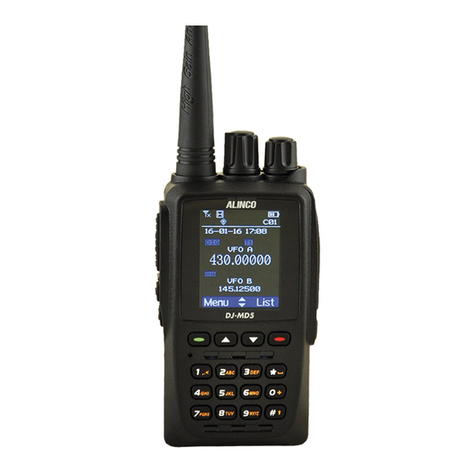
Alinco
Alinco DJ-MD5 User manual

Alinco
Alinco DR-510T User manual
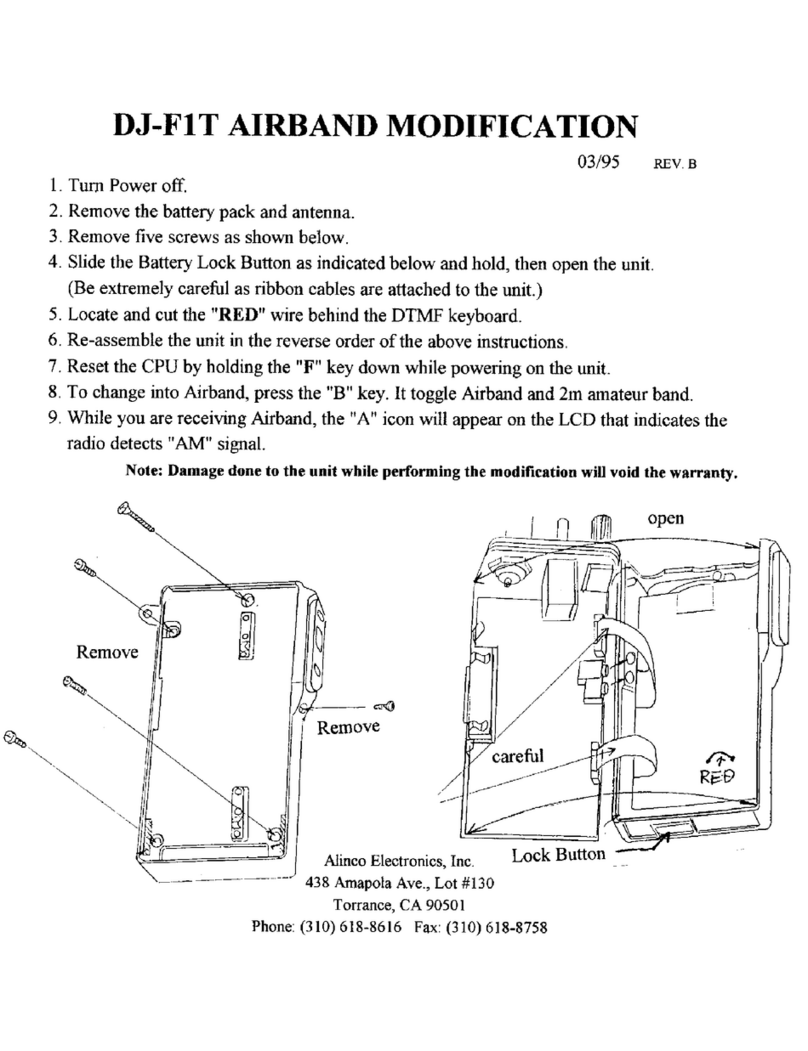
Alinco
Alinco DJ-F1T User manual
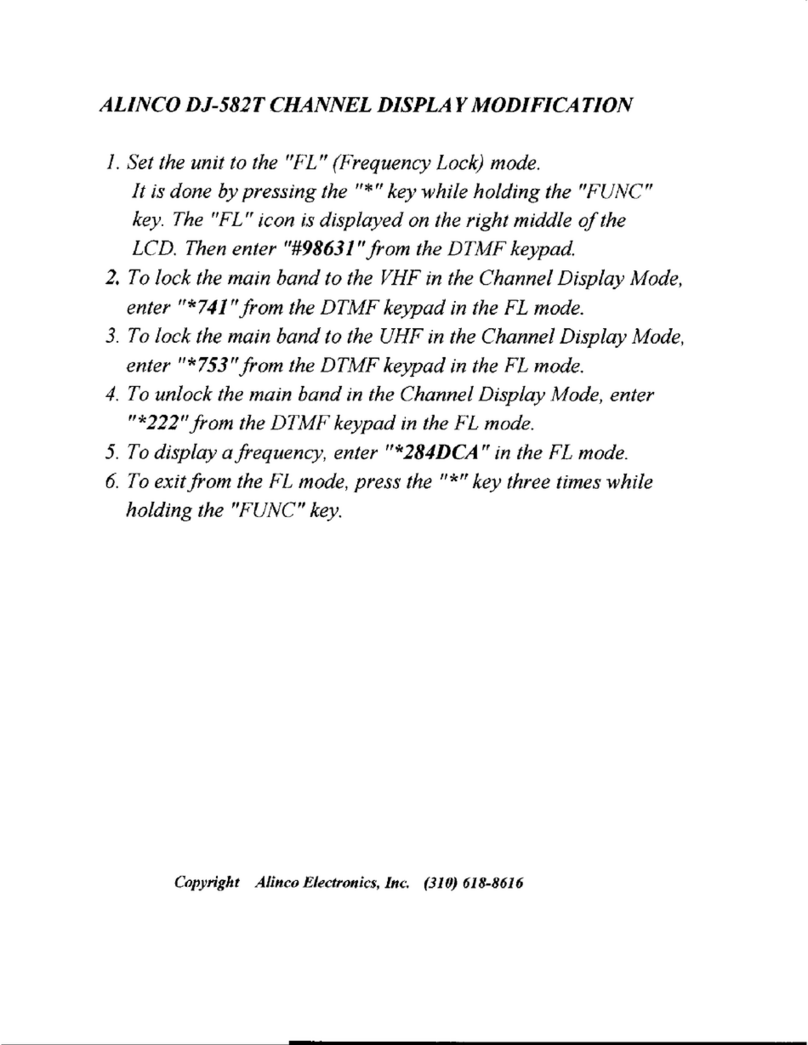
Alinco
Alinco DJ-582T User manual

Alinco
Alinco DJ-180T User manual
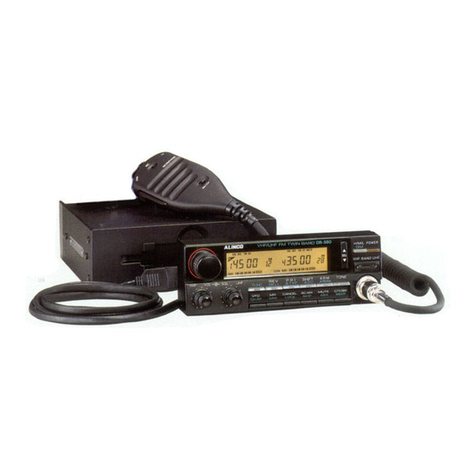
Alinco
Alinco DR-590T User manual
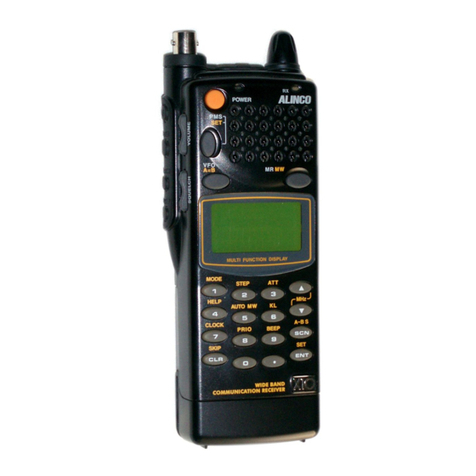
Alinco
Alinco DJ-G5 User manual
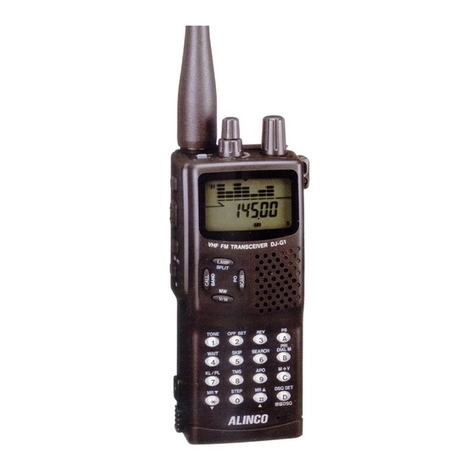
Alinco
Alinco DJ-G1T User manual

Alinco
Alinco DJ-F1T User manual

Alinco
Alinco DR-620T/E User manual
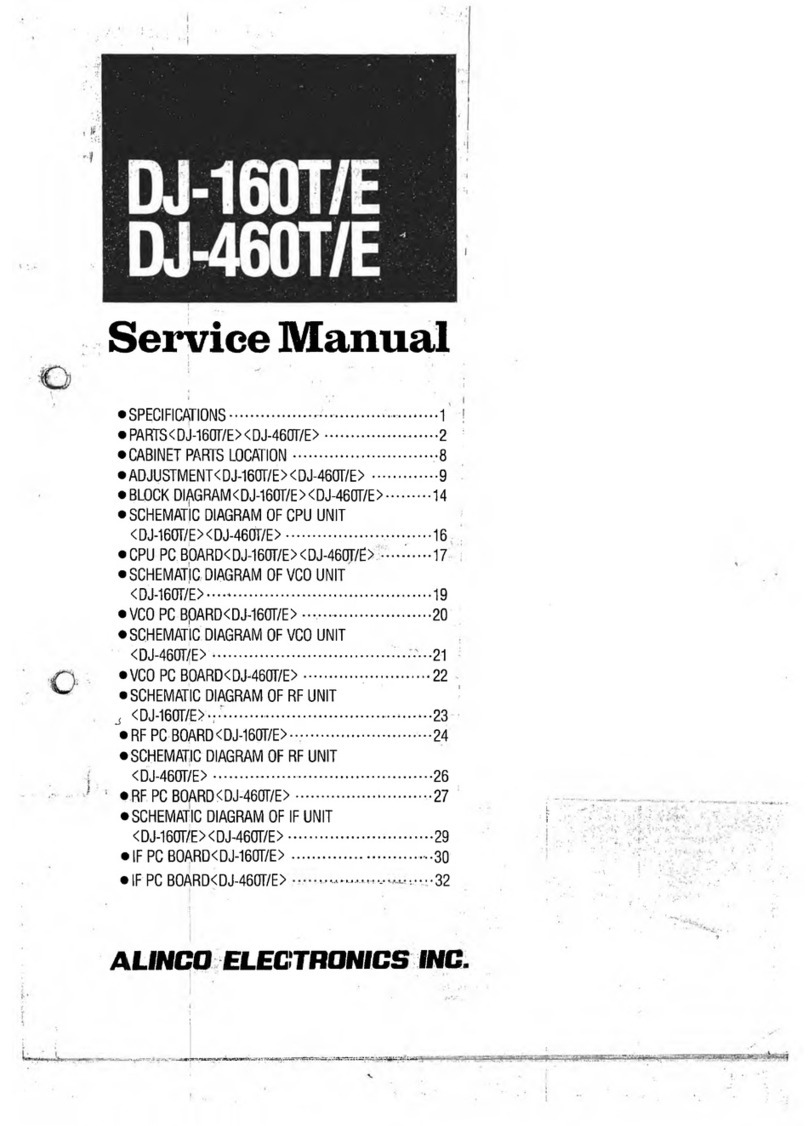
Alinco
Alinco DJ-160T User manual
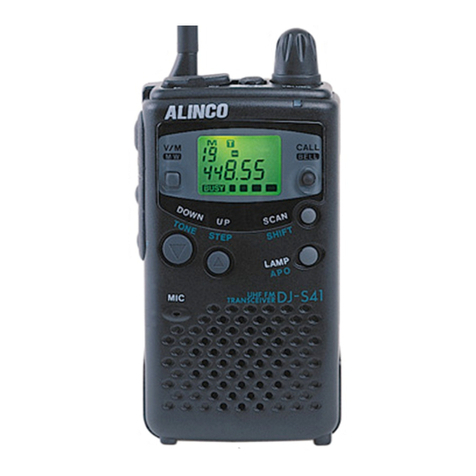
Alinco
Alinco EC10 s User manual
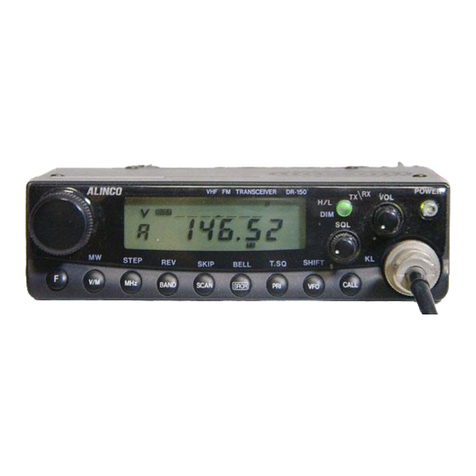
Alinco
Alinco DR-150T User manual
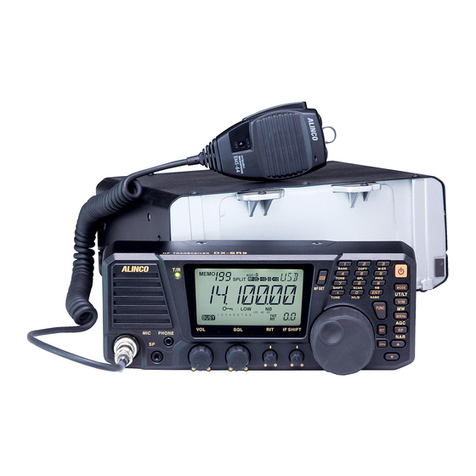
Alinco
Alinco DX-SR9 User manual
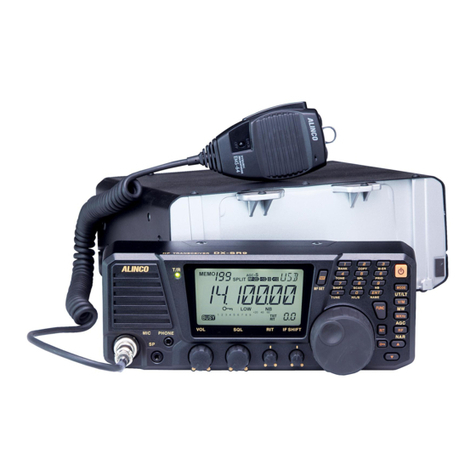
Alinco
Alinco DX-SR9 T User manual

Alinco
Alinco DJ-A10 User manual
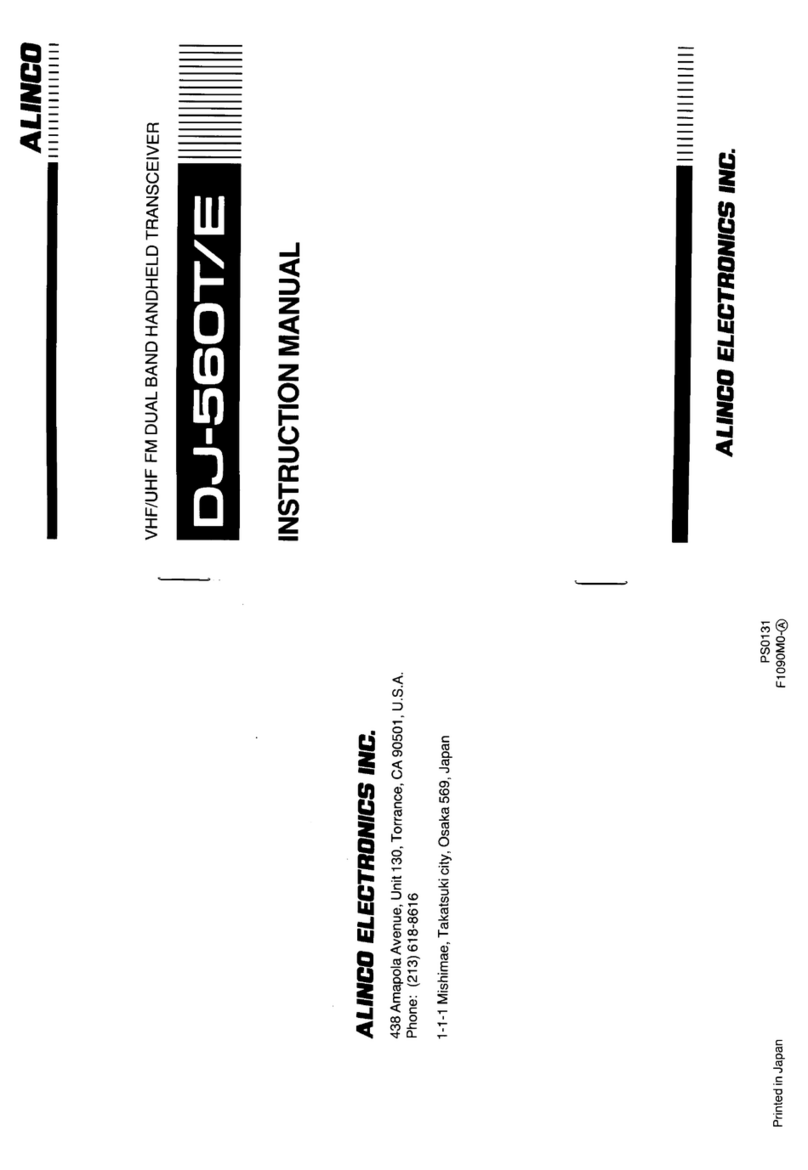
Alinco
Alinco DJ-560t User manual

Alinco
Alinco DJ-560t User manual
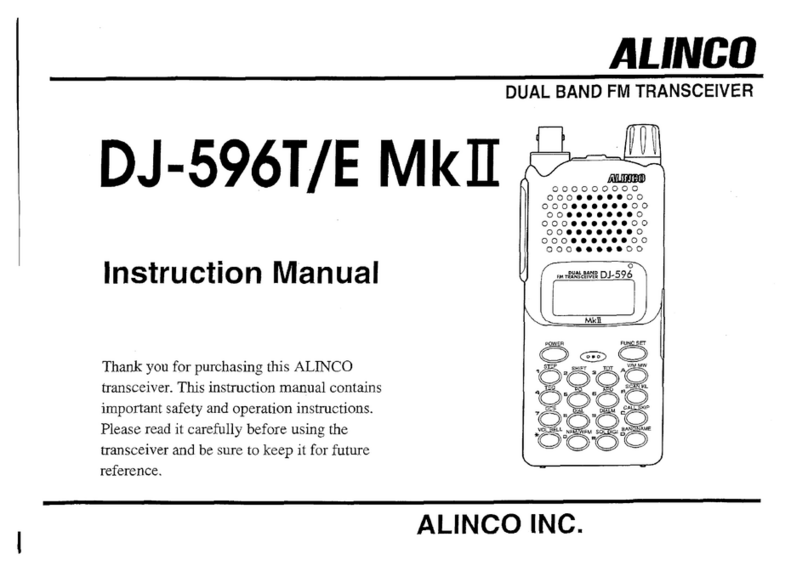
Alinco
Alinco DJ-596T MK II User manual

